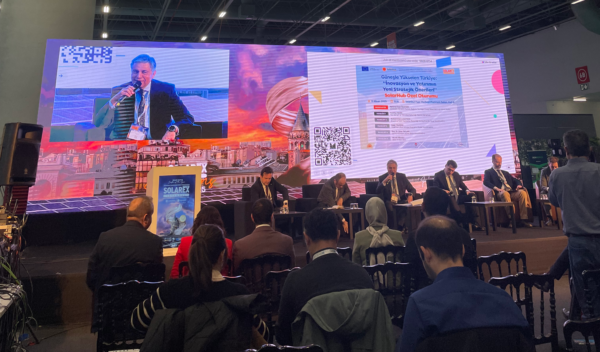The 17th edition of SolarEx Istanbul marked Turkey’s first international solar fair since the government quadrupled its combined solar and wind capacity target late last year to 120 GW by 2035. That figure includes a goal of roughly 76 GW of new solar capacity, building on the more than 21 GW the country has already installed.
The trade fair broke its daily attendance record on April 11 with more than 15,000 visitors, reflecting a shared sense that the target is within reach. During a panel moderated by the Turkish solar energy society GÜNDER, a representative from the Ministry of Energy and Natural Resources said Turkey has already allocated 45 GW of solar projects that have yet to be implemented.
GÜNDER’s session – part of a two-day series of talks during the three-day event – focused on ensuring that this strong project pipeline leads to sustainable, well-managed solar deployment. One key strategy involves building up energy storage alongside solar development. Turkey appears poised to become a leader in the storage market, following the government’s allocation of 33 GWh of storage projects in late 2024.
Of the 45 GW in solar already allocated, 15 GW are tied to storage. That emphasis was evident at SolarEx, where storage had its own exhibition hall and a dedicated conference space throughout the event’s first two days.

While the event drew visitors from more than 125 countries, the strong presence of Turkish solar manufacturers highlighted continued domestic growth. One source told pv magazine that Turkey now has tens of gigawatts of manufacturing capacity, but nearly all producers still import Chinese solar cells before assembling panels locally.
As a result, few qualify under new rules introduced by the Turkish government, such as those in the 800 MW tender earlier this year, which required at least 75% local content in solar panels. The regulation has yet to spur a significant market shift. Another source noted that the domestic market remains overcrowded, with Turkish manufacturers still competing with Chinese suppliers despite a tariff on Chinese panels.
Roughly one-third of SolarEx Istanbul’s exhibitors came from outside Turkey, according to event organizers, with most from China, followed by India and Europe. Despite the international turnout, speakers at the conference noted limited foreign investment in Turkey’s solar sector. Observers pointed out that one of the country’s biggest challenges in meeting its solar targets will be attracting private-sector and international capital – something several neighboring countries have begun to do more successfully.
Another key discussion topic during the three-day event focused on unlocking Turkey’s largely untapped residential solar market. Permitting and investment barriers have slowed uptake, particularly in apartment buildings where most Turkish residents live. However, industry leaders expressed optimism about expanding the use of balcony PV systems, citing their success in several European countries. A new accreditation scheme for plug-and-play systems is in the works, which speakers said would help ensure quality and avoid issues seen in early European rollouts.
Floating solar was also on the agenda. Research published last year found that covering just 10% of Turkey’s dam surfaces could deliver up to 53 GW of solar capacity. At SolarEx, officials discussed the potential inclusion of floating solar in upcoming government auctions.
This content is protected by copyright and may not be reused. If you want to cooperate with us and would like to reuse some of our content, please contact: editors@pv-magazine.com.




By submitting this form you agree to pv magazine using your data for the purposes of publishing your comment.
Your personal data will only be disclosed or otherwise transmitted to third parties for the purposes of spam filtering or if this is necessary for technical maintenance of the website. Any other transfer to third parties will not take place unless this is justified on the basis of applicable data protection regulations or if pv magazine is legally obliged to do so.
You may revoke this consent at any time with effect for the future, in which case your personal data will be deleted immediately. Otherwise, your data will be deleted if pv magazine has processed your request or the purpose of data storage is fulfilled.
Further information on data privacy can be found in our Data Protection Policy.